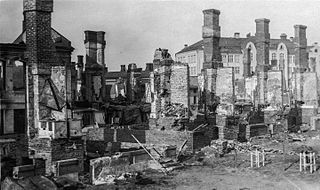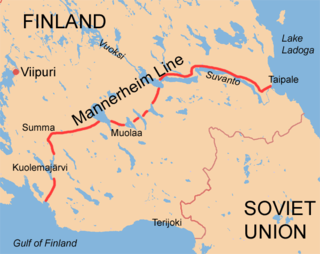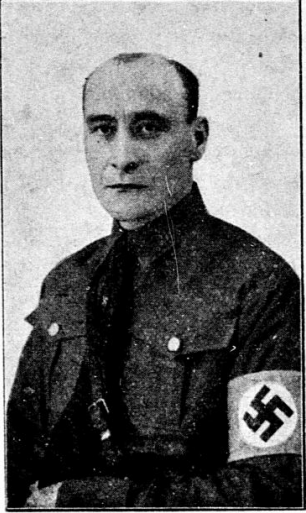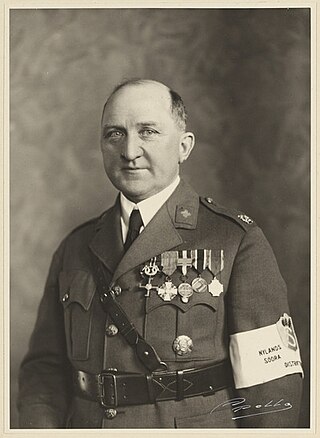
The Finnish Civil War was a civil war in Finland in 1918 fought for the leadership and control of the country between White Finland and the Finnish Socialist Workers' Republic during the country's transition from a grand duchy of the Russian Empire to an independent state. The clashes took place in the context of the national, political, and social turmoil caused by World War I in Europe. The war was fought between the Red Guards, led by a section of the Social Democratic Party, and the White Guards, conducted by the senate and those who opposed socialism with assistance late in the war by the German Imperial Army at the request of the Finnish civil government. The paramilitary Red Guards, which were composed of industrial and agrarian workers, controlled the cities and industrial centers of southern Finland. The paramilitary White Guards, which consisted of land owners and those in the middle and upper classes, controlled rural central and northern Finland, and were led by General C. G. E. Mannerheim.

The Mannerheim Line was a defensive fortification line on the Karelian Isthmus built by Finland against the Soviet Union. While this was never an officially designated name, during the Winter War it became known as the Mannerheim Line, after Finnish Army's then commander-in-chief Field Marshal Baron Carl Gustaf Emil Mannerheim. The line was constructed in two phases: 1920–1924 and 1932–1939. By November 1939, when the Winter War began, the line was by no means complete.

Karl Algot Jansson was a Finnish journalist and radical right-wing activist.

In Finland, the far right was strongest in 1920–1940 when the Academic Karelia Society, Lapua Movement, Patriotic People's Movement (IKL) and Export Peace operated in the country and had hundreds of thousands of members. In addition to these dominant far-right and fascist organizations, smaller Nazi parties operated as well.
The National Socialist Union of Finland, later the Finnish-Socialist Party was a Finnish Nazi political party active in the 1930s, whose driving force and ideologue was Professor Yrjö Ruutu. With an ideology based on Ruutu's theories, the party came to reject orthodox German Nazism.
The People's Community Society was a Finnish-Swedish Nazi organization from 1940 to 1944, founded at Söderkulla Manor in the autumn of 1940 in Söderkulla, Sipoo, Finland. Admiral Hjalmar von Bonsdorff was elected its first chairman and Lieutenant Gunnar Lindqvist its secretary. Sipoo was in the 1930-1940s a center of Finnish-Swedish nazism, as in addition to Bonsdorff, another central Finnish nazi figure Thorvald Oljemark owned manor there. Unto Boman, among others, was present at the inaugural meeting, who in 1941–1944 served as a liaison to the Finnish Waffen-SS volunteer battalion in Berlin. According to him, the idea of forming a battalion was first presented at a meeting of the board of the SF. Other activists of the organization included Pehr Norrmén, an industrialist and banker who was also involved in the recruitment of SS volunteers in the spring of 1941, and Barons Bertil von Alfthan and Torsten Aminoff.

The Finnish People's Organisation was a bilingual Nazi party founded by Jaeger Captain Arvi Kalsta. Supporters of the movement were also called Kalstaites after the leader. The inaugural meeting of the organization was held in March 1933 and was attended by about 500 members. SKJ published the magazines Herää Suomi, Hakkorset and Hakaristi. In addition to its own magazines, the organization had its own publishing house Vasara. The organization wore a brown uniform like the Sturmabteilung of the German Nazi Party, and used the greeting "Finland Awake!"

The Peasant March was a demonstration in Helsinki on 7 July 1930 by the far-right Lapua movement, attended by more than 12,000 supporters from all over the country. It was the most significant show of strength in the short history of the Lapua movement, aimed primarily at the Communists, but it was also intended to put pressure on the Finnish government. President Lauri Relander, Prime Minister Pehr Evind Svinhufvud, among others, were invited guests at the main event held at the Senate Square. In addition present were right-wing MPs, the country's military leadership, and General Mannerheim, commander-in-chief of the Civil War White Army. The peasant march was intentionally reminiscent of the White Victory Parade of 16 May 1918, and also followed its route.
Lennart Reidar Armas Hedman was a Finnish educator, eugenist and far-right politician. He had a master's degree in philosophy. He had studied genetics at the University of Helsinki under Harry Federley.
Ensio Ilmari Uoti was a Finnish politician and Nazi who in the 1930s was the leader of the Finnish-Socialist Workers' Party (SSTP).
Rising Finland was a Finnish political association founded on October 5, 1940. It aimed to "nurture the Spirit of the Winter War", promote the idea of a united people, to reorganize the bourgeois party field and to create a stronger leadership and increasing personal responsibility. According to the organization, its goal was to bring together citizens around national symbols whose value was "perceived by all our people in the great trials of the 1939-1940 War of Independence".

Martti Aleksander Pihkala was a National Coalition Party MP who became known as a Jäger activist, Ostrobothnia White Guard founder, in the 1920s and 1930s, leader of the strikebreaking organisation Export Peace, also known as "Pihkala's Guard" and an influencer of the Lapua movement and the Patriotic People's Movement.

Petter Teodor Forsström was a Finnish industrialist, Vuorineuvos and the father of the Lohja lime industry. Forsström worked as Lohjan Kalkkitehdas Oy's managing director for an exceptionally long period of time, 65 years. In 1946 he was sentenced to prison for treason after participating in the Pro-German resistance movement in the late stages of the Continuation War and during the Lapland War.

The Vaasa riot took place on 4 June 1930 in Vaasa, Finland. The riot unfolded with a violent attack by radical members of the right wing Lapua Movement on Communist supporters and bystanders at a court house in Vaasa. No intervention was witnessed of the police, as the police stood watching the attack.

Vietti Brynolf Nykänen was a Finnish architect, writer and politician.
Niilo Vilho Rauvala was a Finnish engineer and the chairman of the far-right Lalli Alliance of Finland and the Nazi Party of Finnish Labor in the 1930s and 1940s.
The Lalli Alliance of Finland was a Finnish far-right organization founded in 1929. The main themes of the Lalli Alliance were Finnish language nationalism and opposition to communism, parliamentarism and democracy. The aim of the organization was a coup and the appointment of a dictator to lead Finland. The most significant achievement of the organization is considered to be that the Lalli Alliance has been considered to have acted as a precursor to the Lapua movement.
Front Soldier League was a Finnish civil war White Guard veteran organization between the years 1929 and 1944, which also had extreme right-wing political objectives. In the early 1930s, it had close links with the Lapua movement, in which the leaders of the League played an important role. The Front Soldier League was abolished in 1944 on the basis of the Moscow peace treaty, which forbade fascist organizations. It had a sister organization for women, the Front Soldier Women's League, which was also disbanded.
John Rosberg was a Finnish engineer and technical director of the Helsinki Telephone Association who was involved in far-right activities in the 1930s and 1940s.

Kaarlo Henrik Hillilä was a Finnish politician who served as the provincial governor of Lapland (1938–1947), head of the market town of Rovaniemi, minister of the interior (1944–1945), minister of supply (1945–1946), and director general of the Social Insurance Institution (1946–1954).










